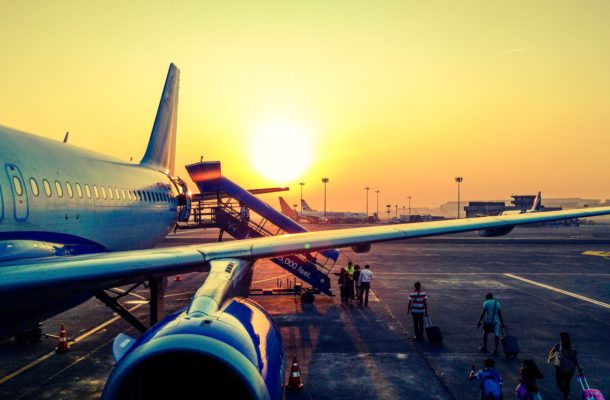The high climate cost of our growing wanderlust

A comprehensive supply-chain analysis from Sydney University has revealed the true cost of our growing desire to travel the world.
Tourism is a trillion-dollar global industry growing faster than international trade and our insatiable appetite for luxury travel continues to increase with income. International tourists from North America and Europe are now joined by the fast growing middle-classes of China, India and other Asian nations.
However key island destinations such as the Maldives, New Zealand and Australia itself are increasingly vulnerable to climate stresses caused by carbon emissions, such as sea-level rises, the reduction of snow caps and coral bleaching, threaten many favourite tourist destinations.
Small islands attract a disproportionate share of carbon emissions, considering their small populations, through international arrivals, and while the United States is responsible for the majority of tourism-generated emissions overall, fast growing Asian regions are making an ever greater contribution.
For the first time, the world’s tourism footprint has been quantified across the whole supply chain, – from flights and cruises to souvenirs – and revealed as a significant and growing contributor to greenhouse gas emissions.
The US tops the carbon footprint ranking, followed by China, Germany and India. While the majority of these carbon footprints are caused by domestic travel, in countries such as the Maldives, Mauritius, Cyprus and the Seychelles, international tourism represents between 30 percent and 80 percent of national emissions.
The paper detailing the research, ‘The carbon footprint of global tourism’, was published in the peer-reviewed journal Nature Climate Change.
The report notes international arrivals and tourism receipts have been growing at an annual rate of three percent to five percent – outpacing the growth of international trade – and tourism is forecast to grow by four percent every year, outpacing most other economic sectors.
Between 2009 and 2013, tourism’s global carbon footprint increased from 3.9 to 4.5 Gt CO2-e – four times more than previous estimates – accounting for about 8 percent of global greenhouse gas emissions, mainly through transport, shopping and food. Air travel emissions alone amount to 12% of tourism’s global carbon footprint.
The research, led by the Integrated Sustainability Analysis supply-chain research group at the University of Sydney, found the global comprehensive tourism footprint of tourism-related greenhouse gas emissions is about four times greater than previous estimates and is already responsible for almost a tenth of global greenhouse gas emissions.
The researchers suggest that financial and technical assistance could help share the burdens caused by global warming on winter sports, sea-level rise on low-lying islands and pollution impacts on exotic and vulnerable destinations. In short, tourists should fly less and pay more to pay for carbon abatement.
Co-author Dr Arunima Malik, from the School of Physics, said the complex research took a year and a half to complete and incorporated more than an estimated one billion supply chains and their impacts on the atmosphere.
“Our analysis is a world-first look at the true cost of tourism – including consumables such as food from eating out and souvenirs – it’s a complete life-cycle assessment of global tourism, ensuring we don’t miss any impacts,” Dr Malik said.
“This research fills a crucial gap identified by the World Tourism Organization and World Meteorological Organization to quantify, in a comprehensive manner, the world’s tourism footprint.”
Co-author Dr Ya-Yen Sun, from the University of Queensland’s Business School and the National Cheng Kung University, Taiwan, said a re-think about tourism as ‘low-impact’ was crucial.
“Given that tourism is set to grow faster than many other economic sectors, the international community may consider its inclusion in the future in climate commitments, such as the Paris Accord, by tying international flights to specific nations,” she said.
“Carbon taxes or carbon trading schemes – in particular for aviation – may be required to curtail unchecked future growth in tourism-related emissions.”
Lead researcher from the University of Sydney, Professor Manfred Lenzen, said the study found air travel was the key contributor to tourism’s footprint and that the carbon-intensive industry would comprise an increasingly significant proportion of global emissions as growing affluence and technological developments rendered luxury travel more affordable.
“We found the per-capita carbon footprint increases strongly with increased affluence and does not appear to satiate as incomes grow,” Professor Lenzen said. Paying for carbon abatement could increase the price of a trip significantly, but may be the only way to reduce demand and fund abatement activities.
While previous research has quantified the carbon footprint of specific aspects of tourism operations such as hotel, events and transportation infrastructure; and in particular countries or regions, this new study included 189 individual countries and all upstream supply chains.

Open Forum is a policy discussion website examining the social, political, economic, cultural and environmental issues of today. We welcome contributions and invite you to follow us on Twitter, Linkedin, Federated Press and Vivaldi Social. We #StandwithUkraine.











